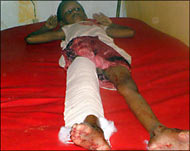Mogadishu toll rises
The death toll in Somalia’s worst fighting for a decade has risen to more than 120.

Hundreds of people were wounded as shells crashed into their homes in Mogadishu’s overcrowded northern shanty town of Siisii and militias battled for control of the capital with mortars, rocket-propelled grenades and anti-aircraft guns.
Many people fled to escape the fighting, which spread to neighbouring heavily populated areas on Thursday.
Hospitals said at least 27 people were killed in fighting that continued overnight.
That brought the death toll from five days of fighting in the failed Horn of Africa state to at least 121.
Residents said more people had died during daylight fighting on Thursday, although chaos in Mogadishu made it difficult to obtain details.
Civilians killed
The fighting is the third round of Mogadishu street battles this year between gunmen allied to Islamic courts and militia from a self-styled anti-terrorist alliance of powerful commanders widely believed to be funded by Washington.
 |
|
Women and children are among |
Most of the dead were civilians and the latest fatalities included a pregnant woman and three children whose house was hit by a mortar.
In another incident, one witness said he saw mortars hit a house twice, killing five members of the same family, including two children.
Siyad Mohamed, a militia leader linked to the Islamic side, said: “Siisii has been turned into a battleground. So many houses have been shelled and hundreds of residents are fleeing. It’s a catastrophe.
“The death toll will definitely rise.”
US ‘links’
Farhan Gure, a resident living near Siisii, said: “Many people fear there will be worse fighting on Thursday night … we have never witnessed such a battle before.”
Analysts view the fighting as a proxy battle between Muslim militia and Washington, which has long viewed Somalia as a terrorist haven.
Some diplomats and security officials say there are a handful of al-Qaeda-linked fighters around Mogadishu.
 |
|
Many have fled the capital to |
The Islamic courts have used Sharia (Islamic) law to provide a semblance of order in the city, in which a million people live and where a power vacuum has fuelled endemic violence for 15 years.
Ali Nur, a member of the warlords’ militia, said the fighting could go on for days.
“It looks like we will continue until a clear winner emerges,” he said.
Aid workers said they feared more casualties as fighting spread to the Karan and Yaqshid districts.
Residents say neither side has gained the upper hand in heavy fighting that underlines the anarchy that has gripped Somalia since warlords ousted Mohamed Siad Barre in 1991 before turning against each other.
A fledgling interim government led by Abdullahi Yusuf, the president, has lacked the authority or resources to make a difference to the lives of ordinary Somalis since it was formed in 2004 and is too weak to return to Mogadishu from its base in Baidoa.
Divided government
Undermined by internal splits, Yusuf’s government includes some Mogadishu militia leaders and some allies of the Islamic courts.
Sheikh Dahir Aweys, a Somali whose name appears on a US list of most-wanted terrorists, has accused Washington of backing the militia leaders.
He says the aim is to avenge the killing of American soldiers in Mogadishu in the 1990s during a UN peacekeeping mission that ended in humiliation.
UN monitors said in a report to the Security Council on Wednesday that they were investigating an unnamed country’s violation of an arms embargo through clandestine support for the warlords’ “Alliance for the Restoration of Peace and Counter-Terrorism”.
The monitors did not identify the country, but Yusuf has named the US as the militia leaders’ backer.